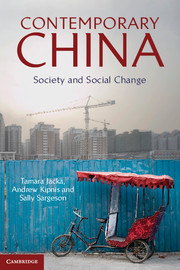Book contents
- Frontmatter
- Contents
- List of Images
- List of Maps
- List of Figures
- List of Tables
- Acknowledgments
- List of Abbreviations
- Map 0.1: China's provinces and provincial capitals
- Introduction
- Part 1 Social Institutions
- Part 2 Cultures, Socialization and the Formation of Identities
- Part 3 Inequalities, Injustices and Social Responses
- Glossary of Chinese Terms
- References
- Index
Introduction
Published online by Cambridge University Press: 05 June 2014
- Frontmatter
- Contents
- List of Images
- List of Maps
- List of Figures
- List of Tables
- Acknowledgments
- List of Abbreviations
- Map 0.1: China's provinces and provincial capitals
- Introduction
- Part 1 Social Institutions
- Part 2 Cultures, Socialization and the Formation of Identities
- Part 3 Inequalities, Injustices and Social Responses
- Glossary of Chinese Terms
- References
- Index
Summary
Chinese society is changing at a breathtaking rate. At the same time as it undergoes what sociologists consider to be classic modernization, including industrialization and urbanization, it is globalizing and embracing new communication technologies. Few western theorists have dared to wrestle with the implications of these complex processes for Chinese society as a whole. Such analysis requires an engagement with the social and institutional legacies of China's revolutionary and pre-revolutionary, imperial past, as well as the momentous forces shaping the present. In this book, three social scientists come together to provide an analysis of Chinese society and social change, informed by anthropological and sociological theory.
The book has three parts. Part 1 examines the most fundamental institutions and forms of organization that shape the everyday lives and social relations of Chinese citizens. Part 2 focuses on the array of cultures and cultural life that may be found across China, and on the socialization and identity formation of young Chinese citizens. Finally, Part 3 discusses various kinds of inequality, division and contention in the Chinese population, and looks at collective actions directed at overcoming perceived social injustices.
Three core themes run through the whole book. The first theme is multiplicity, diversity and stratification. In contrast to the common image of Chinese society as homogeneous, and of “Chineseness” as a singular identity, we highlight the enormous diversity of Chinese identities, cultures and experiences, and differences and inequalities between groups and individuals across the country.
- Type
- Chapter
- Information
- Contemporary ChinaSociety and Social Change, pp. 1 - 24Publisher: Cambridge University PressPrint publication year: 2013

